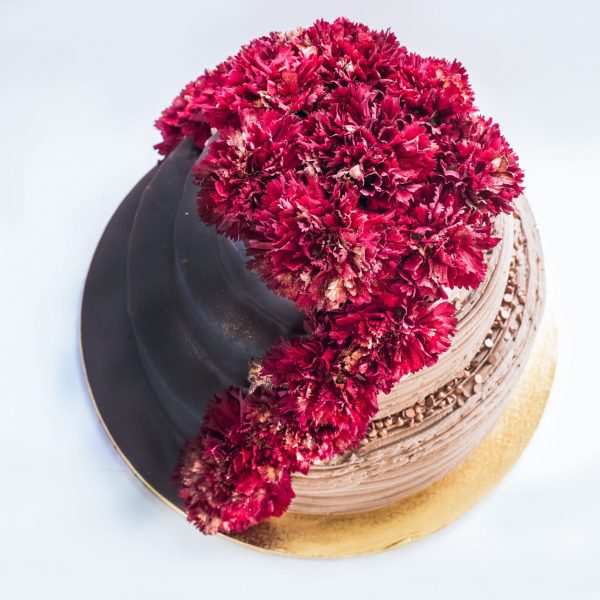
COOKE’S FINEST WEDDING CAKE INFORMATION
Whether a wedding cake is the least of your worries or high on the “must-obsess-over“ list, Cooke’s Finest guide to getting the perfect cake has got you covered. From budgeting to picking out your flavors, we’re going to answer all of your questions—before you even have any.
1. Don’t choose a cake until you’ve made your major wedding style decisions.
You’ll want a cake that’s compatible with the look of your venue, the season, your wedding gown, the flower arrangements and the menu. Arrive at your cake consultation prepared—you don’t need to have a complete sketch in hand, but knowledge of basic terms will make it easier on everyone. And if you’re looking for a custom design, bring along inspiration, like a swatch of lace from your dress or a picture of your wedding china.
2. Do have a budget in mind.
It’s easy to be wooed by blood orange filling and a multi-flavor cake when you’re making decisions with a sugar buzz, but having a handle on your budget—and knowing what will affect it—will allow you to prioritize your choices. For instance, more flavors equals more money; the more complicated the flavor, the bigger the price tag; handmade sugar flowers will add dollars to every slice; and fondant icing is generally more expensive than Frosting.
3. Do match the cake height to your space.
Generally, three tiers will serve 50 to 100, and you’ll likely need five layers for 200 or more guests. Your cake should fit the space too—if your reception is in a grand ballroom, consider increasing the cake’s stature with columns between the tiers, or opting for a faux Styrofoam layer (no one will know!) to add height.
4. Don’t choose the flavor based on what everyone else wants.
Besides being a showpiece, your cake should taste amazing too. When you meet with Cooke’s Finest Team, taste lots of flavors. Don’t be afraid to stray from vanilla and chocolate. And don’t forget to sample fillings too—many bakers are working with complex flavorings, like guava and mango or hazelnut and mocha.
5. Do get the facts on frosting.
Frosting or fondant? Frosting is often much more delicious. But if you love the smooth, almost surreal-like look of fondant, consider frosting the cake in Frosting first and then adding a layer of fondant over the entire confection. Whatever type of icing you choose, stick to colors your guests will want to eat. If your wedding hues are blue and green, opt for a white cake with subtle green-frosted accents.
6. Don’t forget to consider the weather.
If you’re having an outdoor wedding in a hot climate, stay away from whipped cream, meringue and frosting (they melt/get soft). Ask Cooke’s Finest about summer icing options or opt for a fondant-covered cake, which holds up much better against the heat.
7. Do budget for extra details.
When it comes to decoration, adornment costs run the gamut. The most inexpensive option is fresh fruits or flowers that, in some instances, can be applied by your florist for a minimal fee. On the high end are delicate gum-paste or sugar-paste flowers, which are constructed by hand, one petal at a time. But here’s the bottom line: All add-ons—including marzipan fruits, chocolate-molded flowers and lace points—will raise the rate. (For the record, we think it’s worth the cost.)
8. Don’t forget to top it off.
There are many beautiful and unique ways to top your cake. If you have an heirloom piece—especially a fine porcelain antique—work with your baker to integrate it into the cake’s design. It can double as your “something old.“ Other alternatives include a bouquet of sugar flowers, a cascade of icing ribbons or even a sugar block carved to reveal your new monogram. Look to your locale as well. A cluster of coral can look stunning for a beachside celebration, or try a fondant snowflake for a winter wedding. Or don’t use one at all—some designs look great without a topper.
9. Do have a detailed delivery plan.
Cake delivery takes coordination (and usually an air condition van), so give yourself peace of mind and opt to have your cake delivered. Complex cakes may not necessarily arrive in final form, so allow time and space for assembly. And make sure that once the masterpiece is delivered, it has a place at the venue (especially if it requires refrigeration). Bottom line: Discuss all the delivery details with us before signing the contract.
10. Do give your cake the spotlight.
Your cake will likely be on display before it’s cut and consumed. You should have a designated, well-lit table that allows the best presentation possible. A round table is perfect for circular cakes, but a linear design may call for a rectangular table. Drape the table with sumptuous fabrics and decorate it with motifs, colors and flowers to match the cake and your wedding style.
11. Don’t forget to eat your cake (seriously!).
Couples often don’t get a chance to eat their own wedding cake (besides the bite you feed each other). Ask your caterer to save some extra for you. Share it with your new spouse postwedding for a late-night snack or as postwedding brunch dessert.
12. Don’t let freezer burn happen.
Even if you take the most painstaking packaging measures, eating the top tier of your cake on your first anniversary sounds far better than it tastes. Think about indulging on your two-week or one-month anniversary, and treat yourself to a fresh cake in the same flavor when you’ve hit the one-year mark. If you must adhere to tradition, tightly wrap the cake in plastic wrap, then place it in an airtight baggie.
